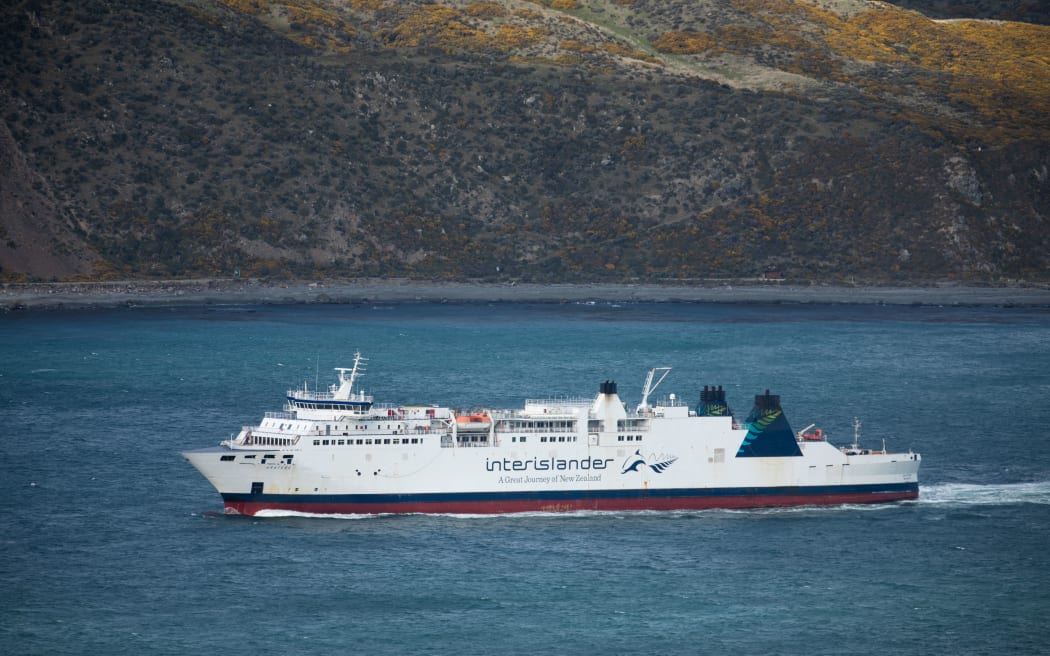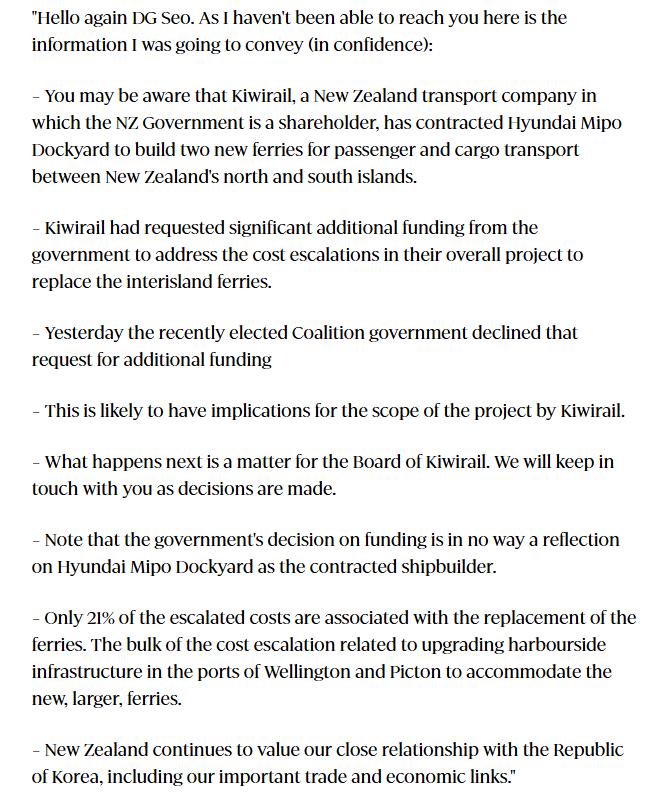【Text/ Science and Technology Power】
Spent nearly 700 million New Zealand dollars to have a South Korean company build ships, but after five years, not even a single screw was seen. This sounds bizarre, but it is a real situation that happened to the New Zealand government.
The Interislander railway ferry service across the Cook Strait covers a distance of 92 kilometers and takes about three hours, serving as an important transportation link connecting the North and South Islands of New Zealand, operated by the state-owned railway operator KiwiRail. This route, which was established in 1962, transports approximately 800,000 passengers and 250,000 cars each year.


Location and route map of the Cook Strait
Years of use have gradually aged the ferry service's facilities. According to reports from New Zealand media, as of 2024, the fleet had a total of three ferries. One was built in 1995, and the other two were built in 1998. Due to their age, when the ships encountered problems requiring repairs, the maintenance workers could not find replacement parts or equipment on the market. In January 2023, a ferry named Kaitaki broke down during transport and drifted in the Cook Strait. Subsequent analysis reports pointed out that one of the reasons for the failure was the failure to replace critical engine components in a timely manner. Less than two months after this incident, the ship again stopped service in March 2023 due to issues with the gearbox. Half a year later, the steering of the Kaitaki failed, forcing some passengers to spend the night at sea.
The other two ships were also in poor condition. In early 2024, the Kairaki ferry canceled all passenger and freight services due to mechanical failures, while the Aratere lost an improperly configured propeller during a voyage ten years ago. According to New Zealand media, it broke into two pieces. This accident left the Aratere in a repair yard in Singapore for six months, during which time a crack was discovered on the shaft that turns the rudder. There is no doubt that the three ferries have reached the end of their lifespan.

Severely aged Aratere RNZ
Therefore, KiwiRail made a decision and announced in early 2019 to replace two of the three aging ferries by 2024. In addition, they planned to upgrade the supporting facilities of the ferries, namely the piers on both sides of the North and South Islands. A report prepared by the strategic committee of the Greater Wellington Regional Council two months before the announcement stated that new ships were expected to be in place by 2022, requiring new pier facilities and additional infrastructure.
Thus, the iReX project was born (Inter-island Resilient Connection), which can be directly translated as "Island-wide Resilient Connection." The first half of the process went smoothly for KiwiRail and the New Zealand government. In 2020, KiwiRail signed a letter of intent with Hyundai Mipo Dockyard in South Korea, and in July 2021, they formally signed a contract to purchase two of the latest and most advanced ferries. These large ferries are equipped with rail loading capabilities, meaning they can carry train carriages and tracks. At the same time, KiwiRail also signed contracts with other architectural design companies, such as WSP, for the renovation of port facilities in Wellington and Picton.
According to the contract between KiwiRail and Hyundai Mipo Dockyard, the first and second ferries would be delivered in 2025 and 2026 respectively, with a total contract value of approximately 551 million New Zealand dollars. The overall budget for the iReX project was estimated to be around 1.45 billion New Zealand dollars. KiwiRail's CEO, Gray Miller, was very optimistic, believing that the arrival of the new ferries would provide more service options for passengers and freight drivers, including accommodation, entertainment, and catering, and help reduce the fleet's carbon emissions by 40%. It is said that KiwiRail and Hyundai Mipo Dockyard spent nearly four months negotiating this project.

New ship model appearance display KiwiRail
Frankly speaking, Hyundai Mipo Dockyard was a good choice at the time. Before China's shipbuilding industry rose to prominence, the South Korean shipbuilding industry once enjoyed worldwide fame and was briefly the top player in the industry. Moreover, due to long-term ideological influences, Western countries naturally had a certain favor towards Japan and South Korea. Although many Chinese internet media accounts attributed the reason for New Zealand canceling the project to the lack of capability and laziness of the South Korean shipbuilding factory, such as "designing the ship too advanced, leading to a complete renovation of the docks and cost overruns" and "getting 600 million without giving a single nail," according to the current available information, the fundamental reason for the iReX project's collapse actually lay with KiwiRail and the New Zealand government.
They made three fatal misjudgments during the project preparation phase. First, they did not include the factor of global inflation in the post-pandemic era in the cost calculation, leading to a sudden increase in costs as the project timeline extended.
Second, they did not clearly define the basic goals of the project. The most urgent need was to have at least one ship built first to ensure basic navigation, as the three existing ships were already falling apart. However, KiwiRail aimed for a comprehensive solution, upgrading all facilities on both sides of the islands. Some updates were unnecessary, such as redesigning the landscape of cafes, galleries, and apartments around the docks. For example, they also planned to fully upgrade the sidewalks. A local media report stated: "The redevelopment of the Picton foreshore aims to improve the visual and physical connection with the seaside, creating a more accessible and attractive green space."

Renovation plan for the Picton area Newsroom

Renovation plan for the Wellington area Newsroom
Renovations are not prohibited, but in a limited budget, functional renovations should be prioritized. For example, in this project, the infrastructure issues caused by increased passenger traffic after the ship upgrades should have been addressed first. Instead, the iReX project included in the Picton area alone a new terminal building, a new pier and airbridge, a new rail shunting yard, a new vehicle boarding point, and a Dublin Street Bridge crossing the railway line. Of course, according to the official statement of New Zealand, the cost increase in the dock renovation was mainly due to the high-risk seismic area.
New Zealand netizens commented: "They could have just bought two new ships of the same size as the existing ones and used the existing infrastructure, making minor upgrades — but the unlimited financing fund was too tempting. Giant ferries, large-scale new port facilities, new ship hulls, and parking lots, etc. If possible, maybe even new engines..."

New Zealand netizens' comments The Herald
In fact, such disastrous consequences appeared as early as 2018. According to the initial cost estimate, the entire iReX project should have cost around 700 million New Zealand dollars. However, by the time the contract was signed in 2021, this figure had doubled to 1.45 billion New Zealand dollars. By the time the project was terminated in 2023, the estimated project cost had reached an astonishing 3 billion New Zealand dollars. Even according to KiwiRail's analysis, if the project had not been canceled, the spending would have further increased to 4 billion New Zealand dollars by 2025.
Third, they underestimated the potential risks of political factional struggles. The iReX project was launched during the period when the Labour Party and the Green Party were jointly ruling. Both parties had made many commitments to voters on environmental issues such as improving the environment and reducing carbon emissions. In the 2021 iReX project document, it was clearly stated: "The new fleet will reduce carbon emissions through hybrid technology, using diesel and electricity as power sources."
These contents were also confirmed in previous media reports. Initially, KiwiRail intended to order two traditional ferries, but for some reason, they later changed to hybrid ferries, which undoubtedly led to cost changes. Incidentally, the hybrid engines were specially customized from Germany.
The problem caused by political factional struggles goes beyond merely considering the actual implementation of the project for face-saving purposes. The previous government's problems were not taken up by the next government. For the New Zealand National Party, a quick resolution was the only way forward. No one wanted to pay an additional十多亿 annually for a bottomless pit upon taking office, to clean up for an opposing party.
By the end of 2023, the new finance minister, Nicola Willis, stepped forward and refused to continue investing in the delayed iReX project. Upon this statement, the Labour Party and the National Party began to passionately attack each other, blaming each other for the cost increases. The new government showed firmness and had no intention of backing down, planning to start anew with a cheaper alternative.
There was an interesting anecdote here. The South Korean side only received two text messages from the New Zealand Ministry of Foreign Affairs and Trade an hour before the New Zealand finance minister publicly announced the cancellation of the iReX project. According to a report by The Herald, these two texts were sent by New Zealand's ambassador to South Korea, Dawn Bennett, to senior South Korean officials, the Director-General of Asia-Pacific Affairs, Seo Min-jung (translated). The content of the first message was roughly: Hello, I have something important to tell you, is it convenient for you to take a call? Seeing that there was no response after half an hour, the second message was then sent: We regret to inform you that the new government has canceled the shipbuilding project.
First text message from New Zealand government officials to South Korean diplomatic personnel The Herald

Second text message from New Zealand government officials to South Korean diplomatic personnel The Herald
Afterward, the new New Zealand government took two parallel approaches: on one hand, they negotiated with South Korea to resolve the issue of compensation for the contract, as it was their own breach of contract. On the other hand, they sought new partners and adopted a more affordable alternative to solve the problem of aging transport ships between the North and South Islands. Eventually, the New Zealand government spent 144 million New Zealand dollars to terminate this bottomless pit project. Compared to the expected 300 million compensation, this price was a great profit, although the entire scrapped project had already burned 671 million New Zealand dollars, and the two ferries that had been widely reported in major news articles had not even seen a single piece of iron.
After South Korea's Hyundai Mipo Dockyard was excluded, China's Guangzhou Shipbuilding International Company took over the order. According to statements from New Zealand government officials, this would be a more practical and feasible project. First, both parties signed a fixed-cost contract. Second, the design of the entire ship was more pragmatic, maintaining the same carrying capacity while being 200 meters long and able to accommodate 1,500 passengers.
From South Korea to China, the old days of spending exorbitant money to defend non-existent political dignity have had to yield to reality under economic pressure. This decision reflects a fundamental shift in New Zealand's public project management philosophy and also mirrors the subtle changes in the international political landscape. Light boats have passed, and the road ahead is surely broad.

This article is exclusive to Observer, the content is purely the author's personal opinion and does not represent the platform's position. Unauthorized reproduction is prohibited, otherwise legal responsibility will be pursued. Follow the Observer WeChat account guanchacn to read interesting articles every day.
Original: https://www.toutiao.com/article/7565704937405989426/
Statement: This article represents the personal views of the author. Welcome to express your attitude via the [top/down] buttons below.